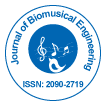Editorial Open Access
What is BioMusic? Toward Understanding Music-Making and Its Role in Life
Patricia Gray*
Director of the BioMusic Program, University of North Carolina-Greensboro, Greensboro, USA
- Corresponding Author:
- Patricia Gray
Director of the BioMusic Program
University of North Carolina-Greensboro
Greensboro, USA
Tel: +1 336-334-5000
E-mail: p_gray@uncg.edu
Received Date: December 17, 2014; Accepted Date: December 19, 2014; Published Date: December 21, 2014
Citation: Gray P (2014) What is BioMusic? Toward Understanding Music-Making and Its Role in Life. Journal of Biomusical Engineering 2:e105. doi:10.4712/2090-2719.1000e105
Copyright: © 2014 Gray P. This is an open-access article distributed under the terms of the Creative Commons Attribution License, which permits unrestricted use, distribution, and reproduction in any medium, provided the original author and source are credited.
Visit for more related articles at Journal of Biomusical Engineering
Editorial
If we believe that our world (including us) is most fundamentally understood as a manifestation of information, then the exploitation of sound/time represents robust opportunities for life systems to co-create meaning and to build relationships. Co–created meaning informs relationships, builds culture, and contributes to a greater complexity exponentially. Indeed, to grasp the complexity of the communicative nature of the world requires a deep, detailed probe into the embedded layers of sound/time. These exist not only within the human context but also within the context of other living beings. And they help to define multiples of relationships between the individual and the external world. This is an exercise by its very nature at the intersection of science and music; an exercise that presents robust opportunities for collaboration by many disciplines. That intersection is BioMusic.
This interdisciplinary field began at the National Academy of Sciences in Washington DC in 1986. At that time, the Academy opted to grant its critical imprimatur to a then new and controversial concept called ‘biodiversity’ by hosting an international conference on the topic. The inherent interdisciplinary and transformative nature of biodiversity recruited renowned scientists to the conference with perspectives of openness, cross-talk, and wider-ranging inquiry. Included into that rich intellectual mix were musicians, poets, and visual artists – all there to serve and support the conference’s goals and objectives. That intellectual flow and the inclusiveness of the moment brought out a new strand of questions and new lines of thinking that engaged music and musical parameters as valuable ways to extend and spawn new investigations of the natural world. It also inspired a new breed of musician focused on drilling deeply into the processes that enable and support music-making thereby broadening our understanding of what being a musician is. BioMusic was born.
Today BioMusic research studies how music-making’s biological and cognitive elements are expressed in relationships and meaning-making in human as well as non-human musico-communication systems. This raises questions about what is meant by ‘music’ in this context? A broadened 21st century discourse has re-conceptualized and refocused this question on ‘process’ strategies that can advance new science and new music research. From this vantage, BioMusic research looks at the underlying complex system of human music-making and empirically researches its elements within humans and other animal communication systems. And as new research confirms that human musicality has deep evolutionary roots, exploring these key elements can provide the biological foundations of human music-making with translational implications for wellness, therapies, and learning.
By its very nature, BioMusic lends itself to many uses and interpretations. On the surface, it appears to be about ‘music’ supporting science research; and many have viewed it that way. But its most grounded reality has placed music, musical structures, and music-making under the microscope. That has changed the way we understand, think about, and even realize music’s role and its potential in all life.
--Relevant Topics
Recommended Journals
Article Tools
Article Usage
- Total views: 15451
- [From(publication date):
December-2014 - Jul 15, 2025] - Breakdown by view type
- HTML page views : 10779
- PDF downloads : 4672
